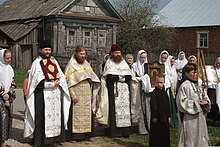Russian Orthodox Old Ritualist Church
The Russian Orthodox Old Ritual Church ( Russian Русская Православная Старообрядческая Церковь ) is an Orthodox Church of the Old Believers (Popowzy), which resulted from a split in the Russian Orthodox Church in the second half of the 17th century Nikon of the liturgical reforms within the Russian Orthodox Reformation of the 17th century Russia arose. The Russian Orthodox Old Ritual Church rejected the changes made by the Patriarch Nikon and retained the Old Russian Rite .
Churches of the Priestly Old Believers
From the 18th century to 1988 the official name of the Russian Orthodox Old Ritual Church was: "Old Orthodox Church of Christ" ( Russian Древлеправославная Церковь Христова ). It is not to be confused with the Russian Old Orthodox Church (Hierarchy of Novosybkow) ( Russian Русская Древлеправославная Церковь ), another Church of the Old Believers. "Drewleprawoslawije" ("Old / Ancient Orthodoxy") was the common self-designation of the Old Believers and their cause since the 17th century.
The Russian Lipovan Orthodox Old-Rite Church is - together with the " Lipowanischen Christian Church of the Old Rite " ( Russian Русская Православная церковь ) - one of the two churches of Old Believers, which the hierarchy of Belaya Kriniza (Russian Белая Криница, today Ukrainian Bila Krynytsia , Romanian Fântâna-Albă ; a village in Chernivtsi Oblast , Ukraine ). Since 1940 the seat has been in Brăila , where a significant Lipovan minority still lives today.
The head of the Russian Orthodox Old Ritualist Church has had the title of Metropolitan of Moscow and All Russia since 1988 . The Metropolitan resides in the Rogozhskoye Cemetery in Moscow . The current metropolitan is Kornili (Titov); the former bishop of Kazan and Vyatka, was elected by the Holy Council on October 18, 2005. He was introduced as a Metropolitan on October 23, 2005.
Belokrinitskaya hierarchy
Bishop Pawel Kolomenski (Павел Коломенский) was the only bishop who had rejected Nikon's reforms. When he died a martyr's death in 1656 , the Old Believers had no high clergy who could ordain new priests. They therefore had to poach new priests from the official Russian church and give them the sacrament of the anointing of the myron, making them indirectly dependent on the official church. In 1848 Old Believers in Austria won the canonically consecrated Greek Bishop Ambrosios (Andrei Georgijewitsch Popowitsch) of Sarajevo and Bosnia , who had to give up his bishopric under pressure from the Turkish authorities, for Old Belief property. In 1849 Ambrosios consecrated Bishop Kiril (Timofejew) and Sophroni, Bishop of Simbirsk , in the monastery of Bila Krynyzja, in the then Austrian Bukovina , and thus established the Belaya Krinitsa Old Believer hierarchy.
Tsar times
The activity of the hierarchy of Belaya Krinitsa on the territory of the Russian Empire was hampered by numerous attempts at obstruction by the imperial Russian authorities as well as by an internal split. The situation changed fundamentally with the publication of the so-called Edict of Tolerance of the Tsar of April 17, 1905 "On the consolidation of the foundations of freedom of belief", which shortly afterwards saw the "unsealing" of the altars in the most important religious and cultural center of the Old Believers, the Rogoschskoye Cemetery followed and allowed the Old Believers an unhindered development of their church life.
Soviet era
After the Bolsheviks came to power in 1917 and during the civil war , the ancient ritualistic church, like its former rival, the “Niconian” Russian Orthodox Church, was subjected to innumerable suffering and persecution. In 1940, Sawa, the bishop of Kaluga , the only ancient ritualist bishop not imprisoned by the Soviet authorities, appointed an irinarch, the bishop of Samara and Ufa , bishop of Moscow. The period of persecution was followed by a period of relative stability, albeit under strict control by the Soviet secret services. But even the period of perestroika and the subsequent changes in political, cultural and economic life had little influence on the position of the ancient ritualistic church in Russian society. The 17-year term of office of Metropolitan Alimpi (Gusew), who was elected in 1988, was seen as a time of "recollection".
present
His successor, elected in 2004, Metropolitan Andrian (Tschetwergow), showed himself to be a talented and charismatic leader who worked intensively for the formulation and dissemination of the cultural and religious "message" of the Old Believers for modern Russian society. Despite portraying himself as traditionalist and conservative in his public statements, Andrian made a significant step forward in dialogue with the Russian Orthodox Church and the Russian political establishment. Due to the sudden death of Metropolitan Andrian on August 10, 2005 during a pilgrimage in the pre-Urals, this “new course” came to a temporary end. However, the new Metropolitan Kornili, who was elected on October 18, 2005, confirmed that he wanted to continue the policy of openness to Russian society that his predecessor had begun.
organization
The head of the Church is the Metropolitan of Moscow and All Russia, who is based in the Rogozhskoye Cemetery in Moscow. He is elected by the highest body of the Church, the Holy Council (Освященный Собор). The council also appoints the members of the Metropolitan Council. The Russian Orthodox Old Ritualist Church is estimated to have around 500,000 members today.
The church has five local bishops and more than 250 parishes in Russia, Ukraine , Belarus and Kazakhstan . The Russian Orthodox Old Ritualist Church has 12 eparchies , eleven are on the territory of the former Soviet Union and one is in Germany: Moscow, Kiev and Ukraine, Kishinev and Moldova, Novosibirsk and Siberia, Yaroslavl-Kostroma, Saint Petersburg-Tver, Nizhny Novgorod and Vladimir, Kazan-Viatka, Don and Caucasus, Urals and Far East. The Augsburg Eparchy includes Germany and the Baltic States.
For several years there have been attempts to restore schools for the training of priests for the ancient ritualistic church.
First ruler of the hierarchy of Belaya Krinitsa
in Hungary and Romania (in Bila Krynyzja , temporarily in Brăila , Romania):
| Ambrosios (Amvrosi), Metropolitan of Belaya Krinitsa | October 28, 1846 - July 26, 1848 († October 30, 1863) |
| Kiril (Timofejew), Bishop of Belaya Krinitsa and Metropolitan of all ancient ritualistic Orthodox Christians |
January 4, 1849 - † December 2, 1873 |
| Afanasi (Makurow) | May 9, 1874 - † October 1, 1905 |
| Makari | September 10, 1906 -? |
| Silujan | 1936 - † around 1941 |
| Innokenti (Usow) | 1942 |
| Tikhon (Kachalkin), Metropolitan of Belaya Krinitsa | 1943 - † March 4, 1968 |
| Joasaph | 1972--1982 († January 2, 1985) |
| Timon (Gavrilow) | 1985 - August 21, 1996 |
| Leonti (Isotow) | Oct. 24, 1996 - now |
in Russia
| Sophroni, Bishop of Simbirsk | January 3, 1849 - 1853 |
| Antoni (Schutow), Bishop of Vladimir 1853 - 1863; Bishop of Moscow and All Russia |
1863 - † 1881 |
| Sawati (Levschin), Bishop of Moscow | October 10, 1882 - 1898 |
| Joann (Kartuschin), Bishop of Moscow and All Russia | October 16, 1898 - † April 24, 1915 |
| Meleti (Kartuschin), Bishop of Moscow and All Russia | August 30, 1915 - † 1934 |
| locum tenens : Wikenti (Nikitin), Bishop of the Caucasus | 1934 - † April 12, 1938 (imprisoned) |
| Sava, Bishop of Kaluga, Smolensk and Bryansk | † 1943 |
| Irinarch (Parfenow), Bishop of Moscow and All Russia | 1940 - † March 7, 1952 |
| Flawian (Slesaryev) | March 16, 1952 - † December 25, 1960 |
| Josif (Morschakow) | February 19, 1961 - † November 3, 1970 |
| Nikodim (Latyshev) | October 24, 1971 - † February 11, 1986 |
| locum tenens : Anastasi (Kononow) | February 14, 1986 - † April 9, 1986 |
| locum tenens : Alimpi (Gusew), Bishop of Klintsi | April 13, 1986 - July 6, 1986 |
| Alimpi (Gusew) | July 6, 1986 - † December 31, 2003 |
| Andrian (Tschetwergow), Metropolitan of Moscow and All Russia |
February 9, 2004 - † August 10, 2005 |
|
locum tenens : Joann (Wituschkin), Bishop of Kostroma and Yaroslavl |
August 11, 2005 - October 18, 2005 |
| Kornili (Titov) | Oct 18, 2005 - now |
See also
Web links
- Official Website (Russian)
- OrthodoxWiki Russian Orthodox Old Ritualist Church
- Sedmitza - Old Believers today (TV program (English))
- From the history of the Old Believers
Individual evidence
- ↑ Russia News: Russian Old Believers elect new head ; News from October 20, 2005.


